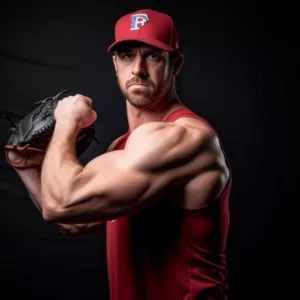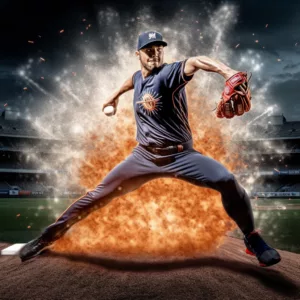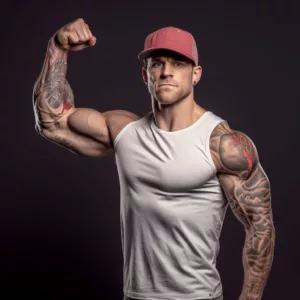 Need help on how to treat a pitcher's arm? This is the guide for you!
Need help on how to treat a pitcher's arm? This is the guide for you!
The act of pitching in baseball puts enormous strain on a pitcher's arm since the repetitive and violent throwing motion can result in a variety of arm ailments if not managed properly. This comprehensive book attempts to look into effective ways and procedures for treating a pitcher's arm, ultimately protecting the health and endurance of these vital sportsmen.
Throughout this tutorial, we will thoroughly examine practical ideas and approaches for treating pitchers' arm injuries. Pitchers can effectively manage their arm health by applying the insights and advice presented, supporting sustained performance, and extending their careers in the sport.
Table of Contents: How do you treat a pitcher's arm?
- Understanding Pitching Mechanics
- Common Arm Injuries in Pitchers
- Identifying Arm Injuries
- Pitcher's Arm Rest
- Initial Treatment and Recovery
- Rehabilitation and Physical Therapy
- Exercises for Strength and Conditioning
- Pitching mechanics that work
- Arm Health Nutrition and Hydration
- Arm Recovery Supplements and Medications
- Pitcher's Arm Alternative Treatments
- Return to Pitching Protocol
- Preventive Measures for Long-Term Arm Health
- FAQs About Pitcher's Arm Treatment
- Conclusion
Understanding Pitching Mechanics
 To effectively treat a pitcher's arm, it's critical to understand the pitching motion's mechanics. The arm of a pitcher is subjected to substantial stress when throwing a baseball due to the quick acceleration and deceleration required. Pitching's repetitive nature raises the danger of overuse injuries.
To effectively treat a pitcher's arm, it's critical to understand the pitching motion's mechanics. The arm of a pitcher is subjected to substantial stress when throwing a baseball due to the quick acceleration and deceleration required. Pitching's repetitive nature raises the danger of overuse injuries.
Pitchers' Most Common Arm Injuries
Pitchers are prone to a variety of arm injuries, including:
- Rotator Cuff Tears: The rotator cuff is a collection of muscles and tendons that help to support the shoulder joint. Tears in these tissues can result in pain and reduced range of motion.
- Injuries to the Ulnar Collateral Ligament (UCL): Pitchers frequently injure their UCL, which is located on the inner side of the elbow. Tommy John surgery is frequently required to repair UCL damage.
- Tears in the labrum: The labrum is a ring of cartilage that surrounds and stabilizes the shoulder socket. Tears in the labrum can result in shoulder discomfort and instability.
- Muscle Strains: Pitchers may suffer from muscle strains in numerous arm muscles, such as the biceps or triceps.
Identifying Arm Injuries: How do you treat a pitcher's arm?
 A correct diagnosis is required for effective treatment. If a pitcher has prolonged pain or a decline in performance, he or she should seek medical attention. A thorough examination, imaging tests such as MRI or ultrasound, and sometimes a biomechanical analysis of the pitching motion are used to make the diagnosis.
A correct diagnosis is required for effective treatment. If a pitcher has prolonged pain or a decline in performance, he or she should seek medical attention. A thorough examination, imaging tests such as MRI or ultrasound, and sometimes a biomechanical analysis of the pitching motion are used to make the diagnosis.
Pitcher's Arm Initial Treatment Steps
When a pitcher's arm is hurt, there are various things that may be done right once to start the healing process:
- Resting: Resting the arm is critical to preventing further harm and allowing the wounded tissues to heal.
- Ice: Applying ice to the affected area can help lessen discomfort and swelling.
- Compression: Compression wraps or sleeves can assist reduce swelling and provide support to the afflicted area.
- Elevation: Raising the arm can help to reduce edema.
Recovery and Rest: How do you treat a pitcher's arm?
Rest and rehab are critical components of treating a pitcher's arm. Adequate rest from throwing activities allows injured tissues to heal and prevents future injury. The length of rest depends on the severity of the injury, but it is usually advisable to avoid throwing until the discomfort goes away and a complete range of motion is regained.
Rehabilitation and Physical Therapy
 Physical treatment is essential in the healing of a pitcher's arm. A professional physical therapist will create a specific program that focuses on strengthening the muscles that surround the shoulder and elbow, improving flexibility, and reestablishing normal biomechanics. Exercises for rehabilitation may include:
Physical treatment is essential in the healing of a pitcher's arm. A professional physical therapist will create a specific program that focuses on strengthening the muscles that surround the shoulder and elbow, improving flexibility, and reestablishing normal biomechanics. Exercises for rehabilitation may include:
- Range of motion exercises: Range of motion exercises involve gradually extending the range of motion of the arm through controlled movements.
- Strengthening exercises: Exercises that target the muscles of the shoulder, elbow, and forearm in order to enhance stability and prevent the risk of future injuries.
- Proprioception and balance training: Proprioception and balance training: Improving the pitcher's body awareness and balance to improve throwing motion control.
Exercises for Strength and Conditioning
Pitchers should incorporate particular strengthening and conditioning activities into their training programs, in addition to physical therapy, to maintain arm health. These workouts are designed to enhance total arm strength, endurance, and flexibility. The 3X Pitching Velocity Program has all of these lift, drills, and exercises programmed out with many levels for optimal results.
Among the most effective exercises are:
- Resistance band exercises: These are exercises that use resistance bands to strengthen the shoulders and elbows.
- Medicine ball exercises: Medicine ball exercises include throwing medicine balls to replicate the throwing motion and increase arm strength.
- Strength Training: These are lifts like squats, deadlifts, and bench press that build muscle strength which is key to protecting joints.
- Olympic Lifting: These are lifts like clean variations, snatch variations, and jerk variations that are the best for developing a more explosive kinetic chain.
- Plyometric exercises: Plyometric exercises include explosive movements like jumps and sprints to enhance power and endurance.
Correct Pitching Mechanics: How do you treat a pitcher's arm?
 Proper pitching mechanics are critical for decreasing arm tension and avoiding injuries. Follow the pitching mechanics training in the 3X Pitching Velocity Program. Some important characteristics of proper pitching mechanics are:
Proper pitching mechanics are critical for decreasing arm tension and avoiding injuries. Follow the pitching mechanics training in the 3X Pitching Velocity Program. Some important characteristics of proper pitching mechanics are:
- Maintaining a smooth and fluid motion: Avoid jerky or forceful movements to save unneeded stress on the arm.
- Using the lower body to generate power: Transferring energy from the knees and hips via the kinetic chain can help to lessen arm strain.
- Maintaining a consistent release point: Maintaining a consistent release point reduces stress on the elbow and shoulder joints.
Arm Health Nutrition and Hydration
Proper nutrition and hydration are frequently forgotten, yet they are critical in sustaining arm health. A balanced diet supplies the nutrients needed for tissue repair and overall health, while adequate hydration helps keep the joints lubricated. Pitchers should consider the following factors:
- Staying hydrated: Drinking water before, during, and after practice or sports to stay hydrated.
- Consuming a well-rounded diet: Including lean proteins, healthy grains, fruits, and vegetables in your diet can improve muscle rehabilitation and overall health.
- Supplementing as needed: As needed, supplement: Consult a healthcare practitioner to see if any specific supplements can help with arm health.
Arm Recovery Supplements and Medications
 While supplements and drugs should never be used in place of professional medical treatment, they can help a pitcher's arm heal. Before using any vitamins or pharmaceuticals, it is critical to contact a healthcare expert. Some often-used alternatives are:
While supplements and drugs should never be used in place of professional medical treatment, they can help a pitcher's arm heal. Before using any vitamins or pharmaceuticals, it is critical to contact a healthcare expert. Some often-used alternatives are:
- Amino Acids: These supplements, known for building muscle, will help recovery while developing muscle mass and facilitate tissue healing.
- Greens and Reds: These are micronutrient supplements that are critical for restoring the body's many functions as an athlete.
- Glucosamine and chondroitin: These supplements are frequently used to maintain joint health and alleviate arthritic symptoms.
Alternative Pitcher's Arm Treatments
Alternative therapies, in addition to established treatments, may provide further alleviation for a pitcher's arm:
- Acupuncture: Acupuncture is the insertion of tiny needles into particular sites on the body in order to promote healing and pain alleviation.
- Massage therapy: Massage therapy can assist relieve muscle tension and enhance blood circulation, which can aid in the recovery process.
- Cold laser therapy: Cold laser therapy, also known as low-level laser therapy, employs light energy to promote tissue healing and decrease inflammation.
Return to Pitching Protocol: How do you treat a pitcher's arm?
Returning to pitching after an arm injury necessitates a methodical and patient approach. It is critical to adhere to a return-to-pitching protocol, which normally consists of:
- Throwing progression: Throwing progression is the process of gradually increasing the effort, volume, and distance of throws while under the supervision of a coach or medical practitioner.
- Pain and tiredness monitoring: During the throwing program, pay particular attention to any indicators of soreness or excessive fatigue.
- Communication with TopVelocity on a regular basis: Keeping open lines of communication with TopVelocity during the return-to-pitching phase.
Long-Term Arm Health Preventive Measures
 When it comes to sustaining long-term arm health in pitchers, prevention is crucial. Among the preventive measures are:
When it comes to sustaining long-term arm health in pitchers, prevention is crucial. Among the preventive measures are:
- Proper warm-up and cool-down: Include a comprehensive warm-up regimen before pitching, as well as a cool-down routine afterward, to prepare and recuperate the arm.
- Paying attention to the body: Observing any indicators of pain or discomfort and getting medical assistance as soon as possible.
- Preventing overuse: Pitch counts and rest periods are used to prevent overuse injuries.
- Maintaining a balanced training program: To avoid muscular imbalances, balance throwing practice with strength and conditioning activities. The 3X Pitching Velocity Program is an ideal program to follow for best results.
FAQs: How do you treat a pitcher's arm?
- How long does it take to heal from a pitcher's arm injury? The length of recovery depends on the severity of the damage. Minor injuries may necessitate a few weeks of rest and therapy, whilst more serious injuries may necessitate several months or longer to properly recover.
- Is it possible to avoid a pitcher's arm injury? While injuries cannot be completely avoided, good training techniques, rest intervals, and preventive measures can minimize the chance of arm injuries in pitchers dramatically.
- Is it always necessary to have surgery for UCL injuries? Surgery isn't usually required for UCL damage. Conservative therapies such as rest, physical therapy, and a gradual return to pitching may be effective in less severe situations. However, surgical intervention may be required in situations of total rips or chronic symptoms.
- Can pitchers play through arm pain? It is not advised to continue playing with arm aches. Pitchers should seek medical assistance if they are experiencing persistent pain or a decline in performance in order to avoid further injury and facilitate proper healing.
- Are there any workouts to avoid if you have a pitcher's arm injury? Certain exercises, such as heavy weightlifting or throwing too much, might aggravate a pitcher's arm problem. Working with a medical practitioner or physical therapist to identify which workouts are safe and effective during the rehabilitation process is critical.
- Where can I find a certified healthcare expert that specializes in pitcher arm injuries? Consult a sports medicine physician or orthopedic specialist who has worked with baseball players. They will have the knowledge and experience to identify and treat a pitcher's arm issue.

